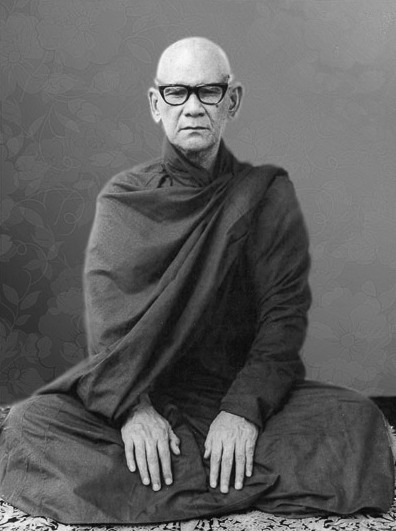INTRODUCTION
On the personal request of the Hon’ble U Nu, Prime Minister, and Thado Thiri Thudhamma, Sir U Thwin, President of the Buddha Sasanna-nuggaha Association, the Ven’ble Mahasi Sayadaw, Bhadanta Sobhana Maha-thera, Sasana-dhaja-siri-pavara-dhammacariya, Agga-maha-pandita, Chattha-sangiti-pucchaka, came down from Shwebo to Rangoon on the 10th November 1949. The Meditation centre at the Thathana Yeiktha, Hermitage Road, Rangoon, was formally opened on the 4th December 1949 when the Mahasi Sayadaw began to give 15 devotees a methodical training in the right system of Satipatthana Vipassana.
From the first day of the opening of the centre a discourse on the exposition of the Satipatthana Vipassana, its purpose, the method of practice, the benefits derived therefrom, etc., has been given daily to each batch of devotees arriving at the centre almost every day to undertake the intensive course of training The discourse lasts usually for one hour and thirty minutes, and the task of talking almost daily in this manner had inevitably caused a strain. Fortunately the Buddha Sasana-nuggaha Association came forward to relieve the situation with an offer of charity of a Tape-Recorder machine with which the discourse given on the 27th July 1951 to a group of 15 devotees undertaking the training was taken on tape-record. Thereafter this tape recorded discourse has been in constant use daily preceded by a few preliminary remarks spoken by the Mahasi Sayadaw.
Then owing to the great demand of many Branch Meditation centres of the Mahasi Satipattana Vipassana as well as of the public, this discourse was published in the book form in 1954. The book has how run to the sixth edition. As there is also a keen interest and eager demand among many devotees of other nationalities who are unacquainted with Burmese the discourse is now translated into English.
U Pe Thin, (translator)
Mahasi Yogi
December, 1957
TRANSLATION
Namo Buddhassa.
Honour to the Fully Enlightened One.
On coming across the Sasana of Lord Buddha it is most important for every one to cultivate in oneself the virtues of Sila, Samadhi and Panna. One should, undoubtedly, possess these three virtues.
Sila is the observance, by lay-people, of five precepts as a minimum measure. For Bhikkhus it is the discipline of Patimokkha Sila. Any one who is well-disciplined in Sila would be re-born in the happy existence of human beings or devas. But this ordinary form of Lokiya Sila would not be a safe-guard against the relapse into the lower states of miserable existence, such as, hell, or animals, or petas. It is, therefore, desirable to cultivate the higher form of Lokuttara Sila as well. This is Magga and Phala Sila. When one has fully acquired the virtue of this Sila he is saved from the relapse into the lower states, and he will always lead a happy life by being re-born as human beings or devas. Every one should, therefore, make it a point of his duty to work for the Lokuttara Sila. There is every hope of success for any one who works sincerely and in real earnest. It would indeed be a pity if any one were to fail to take advantage of this fine chance of being endowed with the higher qualities, for he would undoubtedly be a victim sooner or later of his own bad karma which would pull him down to lower states of miserable existence of hell, or animals, or petas, where the span of life lasts many hundreds, thousands, or millions of millions of years. It is therefore emphasised here that this coming across the Sasana of Lord Buddha is the very opportunity for working for the Magga Sila and Phala Sila.
It is not feasible to work for the Sila alone. It is also necessary to practise Samadhi. Samadhi is the fixed or tranquil state of mind. The ordinary or undiciplined mind is in the habit of wandering to other places; it can not be kept under control; it follows any idea, thought or imagination, etc. In order to prevent its wandering, the mind should be made to attend repeatedly to a selected object of Samadhi. On gaining practice the mind gradually loosens its traits and remains fixed on the object to which it is directed. This is Samadhi. There are two forms of Samadhi, viz., Lokiya Samadhi and Lokuttara Samadhi. Of these two, the practice in Samatha Bhavana viz: Anapana, Metta, Kasina, etc. will enable the development of the states of Lokiya Jhana, such as four Rupa-jjhahanas and four Arupa-jjhanas, by virtue of which one would be re-born in the plane of Brahama. The life span of Brahma is very long and lasts for one world cycle, two, four, eight, up to a limit of eighty-four thousands of world-cycles as the case may be. But at the end of the life-span a Brahama will die and be re-born as human being or deva. If he leads a virtuous life all the time he may lead a happy life in higher existence. But as he is not free from kilesas (defilements) he may commit demeritorious deeds on many occasions. He will then be a victim of his bad karma and will be re-born in hell or other lower states of miserable existence. This Lokiya Samadhi also is not a definite security. It is desirable to work for the Lokuttara Samadhi, which is nothing but Magga Samadhi and Phala Samadhi. To possess this Samadhi, it is essential to cultivate panna.

